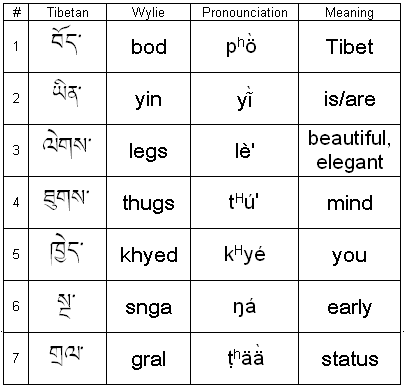Tibetan Pronounciation
Under construction
First and foremost, I am not an expert in Tibetan and I do not speak Tibetan except for the few phrases on the previous page. I am just trying to make something available for those studying the language. Also, this chart has not been checked by anyone and may contain errors. There are places where I have question marks, this means I am unsure of the pronounciation. This chart is compiled from a number of different sources.
As I said, this is very technical, and I seek to most accurately reflect the pronounciation. With this in mind, I have chosen the International Phonetic Alphabet for writing the pronounciation for the most part. So, you will have to familiarize yourself with some new symbols and letters.
This chart is an attempt at conveying the most common dialect - the Lhasa dialect.
Chart Layout
The Tibetan letters are organized descending in the left-most column. Following that, is that pronounciation of the unmodified consonant (no vowels, prefixes, suffixes, attachments). After that, I show which letters can have attachments and their pronounciations. If the attachment is never used for that letter, the boxes are grayed out. A slash in the pronounciation means that it can be pronounced as either.
Symbols Used
Most letters are what you expect them to be, here are a few oddities:
A superscript 'h' indicates light aspiration. Aspiration means blowing out air when you say a consonant - put your hand in front of your mouth and feel for air. Compare "pit" (which has an aspirated p) with "spit" (where the p is unaspirated).
A superscript 'H' indicates heavy aspiration... blowing out more air.
No superscript means no aspiration - this is hard to do for English speakers since most consonants are aspirated, and it will take some practice. You will find that the unaspirated consonants sound a like other letters (k->g, p->b, etc).
An ascending accent over the vowel indicates high tone - the tone of the voice is higher.
A descending accent over the vowel indicates low tone.
An 'n' with a hook represents the "ng" found in "sing". This is also really hard for English speakers because we don't have that sounds at the begining of syllables and words. Try saying "singer", then dropping off the "si".
A dot under letters (t, d, and s) makes the consonant "retroflex". That means the tounge curls back and touches the roof of the mouth when saying it - but not back too far - don't exaggerate.
A t or d without a dot is dental - meaning the tongue touches the back of the teeth when saying it - this is different from their English counterparts.
A c with an accent on top is a "ch".
A j is always like in "job".
An ñ is like in Spanish - it is "ny" like in the word "canyon".
An s with an accent on top is like in "shop".
Base Consonants

Vowels
Vowels are real tricky too. Remember that the base vowel of a consonant "a" is changed by adding vowels above or below the letter. Also, letters after the vowel change the pronounciation. The "x" represents the base consonant in the chart. All the variations and suffixes for each vowel are listed in the columns. Some strange things in this chart:
If a vowel is written once, the duration is short... if it is there twice, the duration is long - you actually say the vowel for more time.
A ' - indicates an abrupt stop.
A ~ over the vowel indicated nasalization. This is tough in English - ask a Portuguese speaker for help with this. A nasalized vowel means the air stops going out of the mouth and starts going out of the nose. Try putting an 'n' sound after these to get the hang of it - it will come naturally.

Putting it Together
So - we need to put the consonant and vowel info together. The consonant info brings with it the consonant sound, aspiration, and tone. The vowel info brings with is the vowel info. Lets do some examples:

Let's go over the features of these syllables pronounciations:
| Number |
Aspiration |
Tone |
Vowel length |
| 1 |
light |
low |
normal |
| 2 |
none |
low |
normal + nasalized |
| 3 |
none |
low |
stop |
| 4 |
heavy |
high |
stop |
| 5 |
heavy |
high |
normal |
| 6 |
none |
high |
normal |
| 8 |
light |
low |
long |
Other Issues
I realize there are a number of issues I have not tackled:
The case of other suffixes - such as "ng". I'm not sure if there are others besides "ng", but they add their own sound to the consonant. So, "ng" at the end does not change the vowel or tone or anything, just adds "ng" sound.
Some rango, sango, and lango consonant stacks for first column consonants (k, c, p, t, ts) - I don't think their pronounciation changes from the the pronounciation of the base consonant, but I'm not sure.
Syllable prefixes: g, d, b, m, 'a - these have the same effect as the superscript consonant stacks. So, for example, dga has the same pronounciation as rga.
I think that is it. Any comments and or corrections are appreciated!
Contact
Go Back



